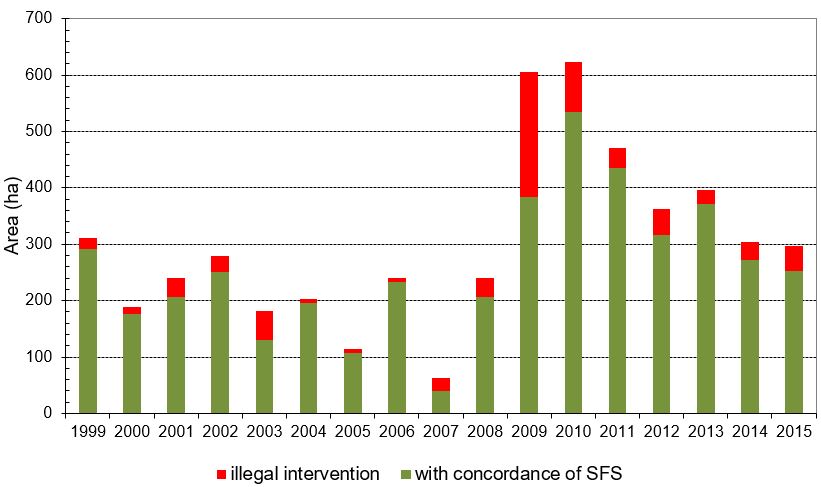[GZ05] Deforestation

Key message

Deforestation represents a negligible percentage of the total forest area in Slovenia. The annual average in the last decade is approximately 360 ha. Until 2008, most deforestation was a result of construction of infrastructure facilities. In 2008, an unprecedented increase in deforestation for agricultural purposes occurred, which accounted for 85% of all deforested areas in 2009. The percentage has remained high ever since, still accounting for 73% in 2015. Until now, deforestation has mostly been carried out with the consent of the competent institutions. In 2009, the proportion of deforestation carried out without consent increased to as much as one third of the deforested area, but declined again in the years that followed.
Definition
This indicator shows the surface area of deforested land, including the areas deforested in accordance with the consent of competent institutions and illegally deforested areas. The data is shown for the period 1999–2015.
In the Forest Act (Official Gazette of the Republic of Slovenia, No. 30/93 and amendments), deforestation is defined as the removal of all forest trees and other forest vegetation due to intended land use change.
Charts
Slovenia Forest Service, 2016
| 1999 | 2000 | 2001 | 2002 | 2003 | 2004 | 2005 | 2006 | 2007 | 2008 | ||
|---|---|---|---|---|---|---|---|---|---|---|---|
| with concordance of SFS | ha | 290.7 | 176.4 | 205.6 | 251 | 129.6 | 196.5 | 106.8 | 232.6 | 40 | 205.6 |
| illegal intervention | ha | 21.2 | 13.1 | 35.1 | 27.7 | 52.6 | 5.8 | 7.4 | 7.6 | 22.9 | 34 |
| total | ha | 311.9 | 189.5 | 240.7 | 278.7 | 182.2 | 202.3 | 114.1 | 240.2 | 62.9 | 239.6 |
| 2009 | 2010 | 2011 | 2012 | 2013 | 2014 | 2015 | |||||
| with concordance of SFS | ha | 384.4 | 534 | 434.5 | 317.2 | 371 | 372.5 | 251.8 | |||
| illegal intervention | ha | 221.3 | 88.5 | 36.5 | 46.2 | 24.6 | 30.9 | 45.6 | |||
| total | ha | 605.7 | 622.5 | 471 | 363.4 | 395.6 | 303.4 | 297.4 |
Goals
To allow deforestation in cases in which it does not significantly affect the ecological function of forests or when public interests requiring forest clearing outweigh the ecological importance of forests.
Comment
Considering the area covered by forest, deforestation represents a negligible percentage of the total forest area. The average for the period 2001–2005 was 205 hectares, while the average for the period 2006–2010 was 354 hectares, which indicates a steeply growing trend. Over the past years, the Slovenia Forest Service considered between 750 and over 1000 applications annually for activities affecting forest land. After 2010, at least 2,300 such activities took place each year.
Before 2008, most deforestation took place as a result of the construction of infrastructure facilities such as motorways, power lines, buildings and other facilities (stone quarries, landfills, dumpsites). After 2008, there was an extraordinary increase in deforestation for the purposes of agriculture. In 2015, 73% of deforested areas were agriculture-related. The main reason for this is the amended Forest Act, which enables deforestation for agricultural purposes on areas smaller than 0.5 ha, where the forest is not designated as a protective forest or a special purpose forest. Additionally, the Decree on direct payments in agriculture was amended in 2008, extending payment rights to “category 1800 – agricultural land covered with forest trees.” In certain landscape types, deforestation was quite extensive and its importance or negative impact was significant, particularly due to the fact that deforestation for the purposes of urbanisation and infrastructure took place mainly in forests in the immediate vicinity of larger cities. Quite a few exceptional forests were cleared for the purposes of infrastructure (motorways, power lines) construction.
In the past, most deforestation was carried out with the consent of the competent institutions. In 2009, the percentage of deforestation that occurred without consent increased to a third, while today it is between 10 and 15 per cent.









